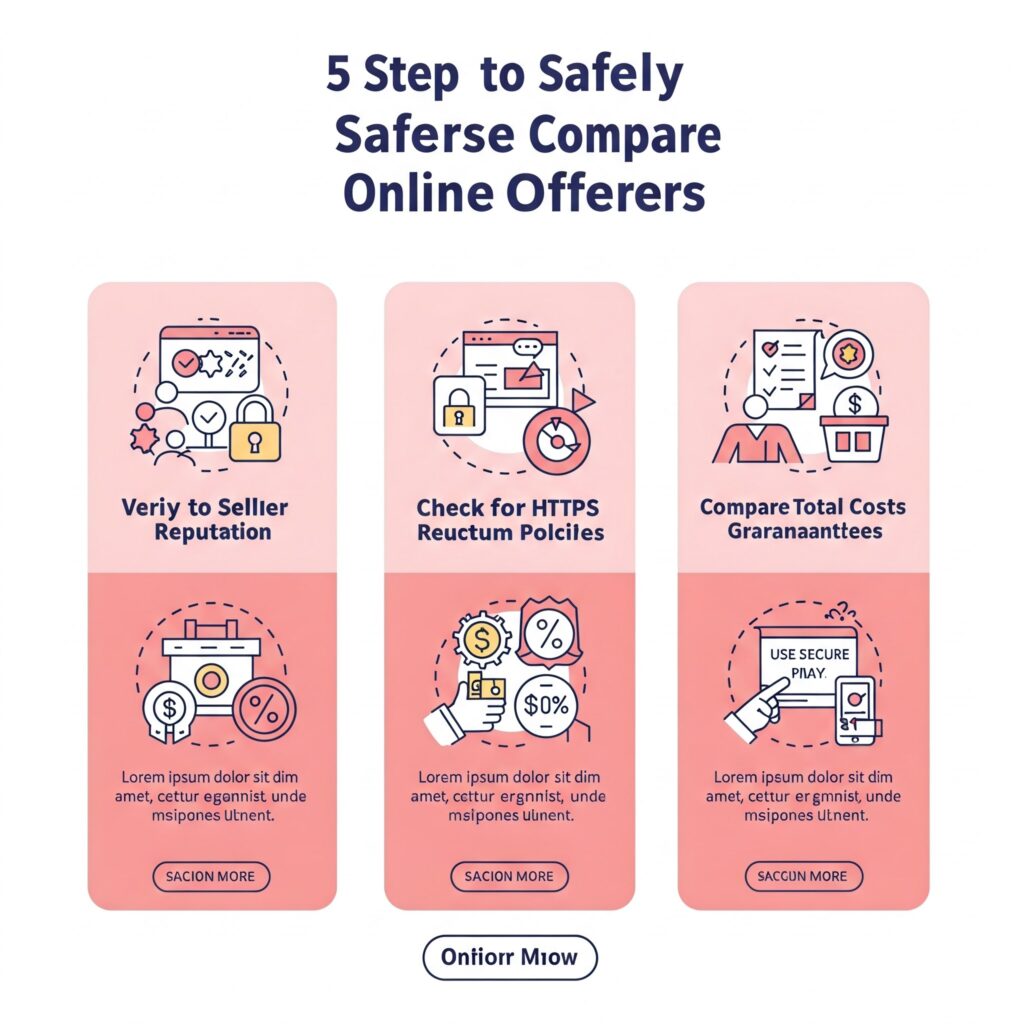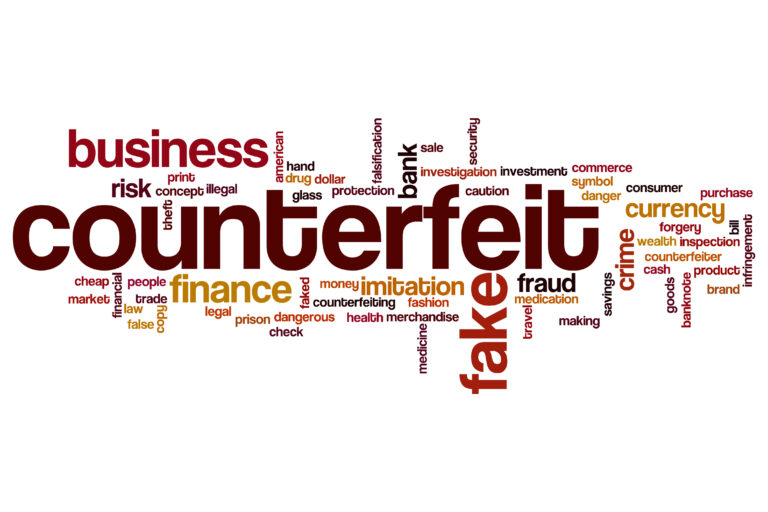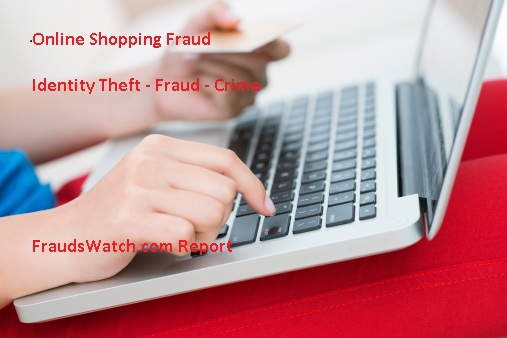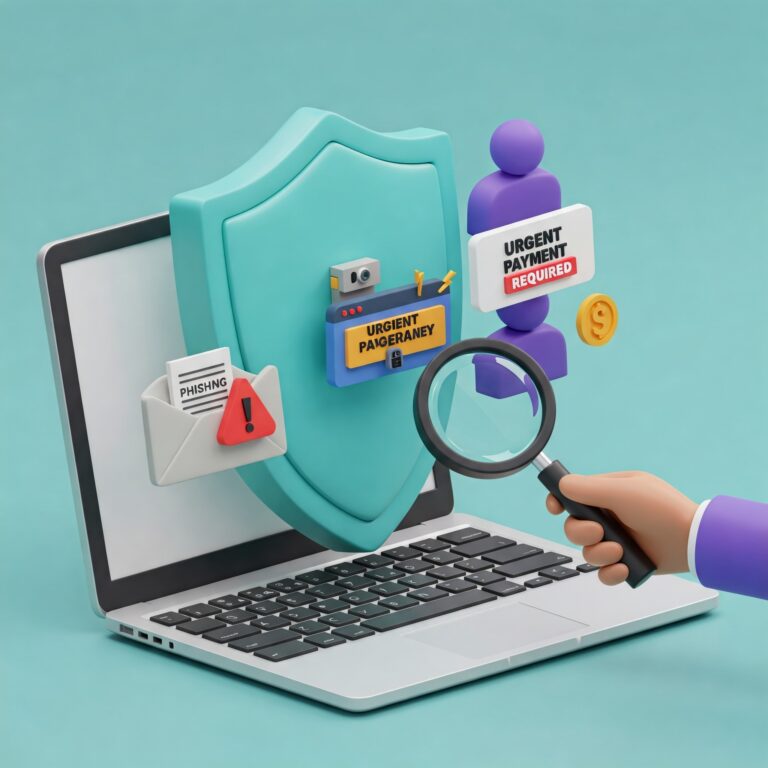Navigating the Digital Marketplace: A Savvy Shopper’s Guide to Comparing Online Offers Safely in 2025

The digital marketplace in 2025 offers an unprecedented array of choices and potential savings, yet it simultaneously presents a landscape fraught with potential pitfalls. The allure of an incredible online deal can be strong, but so too is the risk of encountering sophisticated scams designed to part unsuspecting shoppers from their money and personal information. Comparing online offers has therefore become more than just a strategy for saving money; it’s an essential skill for navigating the complexities of modern e-commerce securely. This guide provides a comprehensive framework for comparing online offers effectively and safely, ensuring consumers can maximize value while minimizing exposure to fraud. The focus here is twofold: securing the best possible deal and safeguarding financial and personal data throughout the process. This involves understanding the true cost of an offer, leveraging the right digital tools, employing smart comparison strategies, recognizing warning signs, and adapting approaches for different types of offers, all while maintaining a vigilant eye towards security. The insights presented are drawn from extensive analysis of current best practices, tool capabilities, and consumer protection guidelines, aiming to establish a foundation of trust and provide actionable advice.
Decoding Online Offers: Look Beyond the Price Tag
The most prominent feature of any online offer is typically its price, but experienced shoppers recognize that the lowest advertised number doesn’t automatically equate to the best overall deal. A truly advantageous offer requires looking beyond the initial sticker price to evaluate the complete value proposition, considering numerous factors that impact the final cost and the post-purchase experience. Failing to do so can lead to unexpected expenses or dissatisfaction with the purchase.
A critical first step is calculating the Total Cost. Many seemingly great deals lose their luster once additional charges are factored in. Mandatory additions like shipping fees, sales tax, and potential handling charges must be accounted for. For international purchases, customs duties or import taxes can significantly inflate the final price. Only by summing all these costs can a true price comparison be made.
Beyond cost, the Product or Service Quality and Features demand scrutiny. Comparing specifications is vital, especially for electronics (processor speed, memory, screen resolution) or technical goods. For apparel or home goods, understanding the materials used, construction quality, and included features is crucial. When comparing services, the scope of what’s included, service level agreements (SLAs), and feature sets differentiate providers even at similar price points.
The Seller’s Reputation and Customer Reviews offer invaluable insights into reliability and trustworthiness. Before committing to a purchase, particularly from an unfamiliar vendor, researching the seller is paramount. Consulting independent review platforms, checking ratings on sites like the Better Business Bureau (BBB), and searching for the company name alongside terms like “complaint” or “scam” can reveal potential issues. Relying on a single review is unwise; reading multiple perspectives provides a more balanced understanding of the seller’s track record and customer service quality. A pattern of negative feedback regarding product quality, shipping delays, or poor customer service should be considered a significant red flag.
Equally important are the Return Policies and Warranties. Understanding the terms for returns, exchanges, and refunds before purchasing is essential. Key questions include: What is the return window? Who pays for return shipping? Are there restocking fees? What warranty coverage is offered, and for how long? Vague or non-existent policies are often warning signs. Clear, fair policies provide recourse if the product is defective, damaged, or not as described.
Delivery Times and Reliability can also be deciding factors. While sellers are legally required to ship items within a certain timeframe (e.g., 30 days in some jurisdictions ), stated delivery estimates and the seller’s history of meeting them matter, especially for time-sensitive purchases. Reviews often comment on shipping speed and reliability.
Finally, while discussed in more detail later, Payment Security is a fundamental consideration even at the initial comparison stage. Ensuring the seller offers secure payment methods is crucial. Notably, using credit cards often provides superior consumer protection against fraud compared to other methods like debit cards or wire transfers.
Evaluating these factors collectively—total cost, quality, reputation, policies, delivery, and payment security—allows for a holistic assessment of value. This comprehensive approach moves beyond simple price matching to identify offers that are genuinely advantageous and minimizes the risk of encountering fraudulent or unreliable sellers. Interestingly, many of these comparison points, such as assessing seller reputation or scrutinizing policies, directly overlap with practices for identifying potential scams, reinforcing the idea that diligent comparison is inherently linked to safer shopping.
Your Digital Toolkit: The Best Online Offer Comparison Tools for 2025
The sheer volume of online retailers and offers makes manual comparison a daunting task. Fortunately, a diverse ecosystem of digital tools—comparison websites, mobile apps, and browser extensions—exists to automate and simplify the process. Understanding the types of tools available and their respective strengths is key to building an effective comparison strategy.
Types of Comparison Tools:
- Comparison Shopping Engines (CSEs): These are websites that aggregate product information and prices from a vast network of online retailers. Users can search for specific products or browse categories to see offers side-by-side. Examples include Google Shopping, PriceGrabber, Shopzilla, and Twenga. CSEs offer broad visibility across many stores, making them excellent starting points for general product searches. However, users should be aware that listed prices might not always include shipping or taxes, requiring a click-through to the retailer’s site for the final cost. Some CSEs also allow retailers to list products via a pay-per-click model.
- Price Comparison Apps: Designed for mobile convenience, these apps often provide features tailored for both online and in-store shopping. Many include barcode or QR code scanners, allowing users to instantly compare the price of an item found in a physical store with online offers or nearby competitors. Popular apps like BuyVia, ShopSavvy, and Flipp (specializing in groceries) also offer features like daily deal alerts, coupon finders, and price tracking watchlists. Availability on Android and iOS platforms is common.
- Browser Extensions: These tools work in the background while users browse retailer websites, automatically searching for lower prices, applying coupon codes at checkout, or tracking price history for specific items. Examples like Honey, Camelcamelcamel (specifically for Amazon), Price.com, and Capital One Shopping offer a more passive way to save money without actively visiting a comparison site. They integrate directly into the browsing experience.
- Niche & Specialized Tools: Recognizing that one size doesn’t fit all, numerous tools cater to specific product categories or regions. Camelcamelcamel is renowned for tracking Amazon price history. PriceBat focuses on computer electronics, particularly for Canadian shoppers. Skinflint serves UK and EU users , while Getprice targets Australian retailers. Flipp excels at comparing grocery flyer prices. TechPrice Sentinel specializes in tracking fast-moving electronics prices. For travel, dedicated platforms like Expedia, Kayak, and Trivago compare flights, hotels, and vacation packages. Emerging AI-powered tools like Pricegenius AI aim to offer predictive insights and personalized recommendations.
Key Features to Look For:
When evaluating comparison tools, consider which features align best with individual shopping needs:
- Barcode/QR Scanning: Essential for comparing prices while shopping in physical stores.
- Price Drop Alerts/Tracking: Allows users to monitor specific items and receive notifications when prices fall to a desired level.
- Price History: Provides historical pricing data to verify if a current “sale” is truly a discount compared to previous prices.
- Coupon/Deal Finders: Automatically searches for and applies available discount codes or highlights ongoing promotions.
- Broad Retailer Coverage: Ensures the tool compares prices across a wide range of relevant stores.
- Ease of Use: An intuitive interface makes the comparison process quicker and less frustrating.
- User Reviews: Access to product or seller reviews within the tool adds another layer of comparison.
- International Capabilities: Necessary for cross-border shopping, including currency conversion and potentially duty/tax estimates.
- Sustainability Focus: Some newer tools incorporate environmental impact data alongside price.
How to Choose the Right Tool(s):
Selecting the best comparison tool depends heavily on personal shopping habits and preferences. Consider:
- Shopping Style: Do you primarily shop online, in-store, or both? Do you prefer active searching or passive background assistance?
- Product Categories: Are you looking for general merchandise, or do you frequently shop in specific niches like groceries, electronics, or travel?
- Feature Needs: Are price alerts, history tracking, or barcode scanning most important?
- Retailer Support: Does the tool cover the stores you frequently shop at?
- User Feedback: Check app store ratings and online reviews to gauge the tool’s reliability and effectiveness.
Given the specialization of many tools, often the most effective approach involves using a combination of resources. For instance, one might use a CSE for initial research, a browser extension for automatic coupon checks, and a specific app for tracking price drops on desired items. While these tools offer significant convenience, particularly extensions that access browsing data, users on security-focused platforms should remain mindful of data privacy implications and review tool permissions and policies.
The following table summarizes key features across different tool types:
Table 1: Top Online Offer Comparison Tool Features (2025)
| Tool Type | Key Features | Example Tools | Best For |
|---|---|---|---|
| Comparison Shopping Engines (CSEs) | Broad Price Comparison, Product Discovery | Google Shopping, PriceGrabber, Shopzilla, Twenga | General product research, Initial price discovery |
| Price Comparison Apps | Barcode Scanning, Price Alerts, Mobile Deals, Watchlists, Coupon Finders | BuyVia, ShopSavvy, Flipp (Groceries) | On-the-go comparison, In-store price checks, Grocery savings |
| Browser Extensions | Automatic Price Comparison, Coupon Application, Price History Tracking | Honey, Camelcamelcamel (Amazon), Price.com, Capital One Shopping | Passive savings while browsing, Automatic coupon application, Amazon tracking |
| Niche & Specialized Tools | Category-Specific Comparison (e.g., Travel, Tech), Regional Focus, Price History | Camelcamelcamel, PriceBat, Skinflint, Expedia, Kayak, Trivago, TechPrice Sentinel | Amazon deals, Electronics, Travel bookings, Specific regions/categories |
| AI-Powered Tools | Predictive Pricing, Personalized Recommendations, Advanced Analytics | Pricegenius AI | Advanced users seeking market insights, Predictive deal finding |
Export to Sheets
By understanding the landscape of available tools and selecting those that best fit their needs, consumers can significantly streamline the process of finding competitive online offers.
Mastering the Comparison Game: Strategies for Finding Genuine Value
Having the right tools is only part of the equation; employing effective strategies is crucial for navigating the complexities of online offers and uncovering genuine value. Simply comparing headline prices is often insufficient. A more strategic approach involves precision, cross-verification, timing, and careful attention to detail.
Be Specific with Search Criteria: Vague searches yield vague results. Instead of searching for broad terms like “laptop,” specify the desired model, brand, key features (e.g., “Dell XPS 15 9530 OLED”), or intended use. This helps comparison tools filter out irrelevant options and present offers that closely match requirements, saving time and improving the accuracy of comparisons.
Use Multiple Tools for Comprehensive Results: No single comparison tool covers every retailer or tracks every possible deal. Relying on just one platform can lead to missed opportunities. Cross-referencing prices and deals using a combination of tools—perhaps a CSE for broad market view, a specialized app for a specific category, and a browser extension for coupons—provides a more complete picture and increases the likelihood of finding the absolute best offer available.
Set Price Alerts for Strategic Waiting: For non-urgent purchases, price alert features offered by many apps and websites are invaluable. Users can set a target price for a desired item and receive notifications when it drops to that level or below. This proactive monitoring allows consumers to buy strategically when prices are most favorable, rather than succumbing to impulse purchases or temporary “sales.”
Check Price History to Validate Deals: The allure of a “sale” price can be misleading if the item’s price was recently inflated. Tools that provide price history data, such as Camelcamelcamel for Amazon or PriceSpy for broader retail , empower consumers to assess the legitimacy of discounts. By viewing past price fluctuations, shoppers can determine if the current offer represents a genuine saving compared to historical norms or simply a return to a previous price point. This historical context is vital for making informed decisions and avoiding deceptive marketing tactics.
Factor in the Total Cost (Revisit): It bears repeating: always verify the final price after all additional costs like shipping, taxes, and potential fees are included. Some comparison tools may not display these upfront. Clicking through to the retailer’s checkout page is often necessary to confirm the true, final cost before making a purchase decision.
Leverage In-App and Tool-Specific Features: Explore the full functionality of chosen comparison tools. Utilize barcode scanners for quick price checks while in physical stores. Create watchlists or shopping lists within apps to organize and track items of interest. Understanding and using these features maximizes the utility of the tools.
Time Purchases Around Sales Events (with Caution): Major retail events like Amazon Prime Day (often held twice a year), Black Friday, Cyber Monday, and various seasonal or holiday sales can offer substantial discounts. Planning significant purchases around these periods can lead to savings. However, it’s crucial to use price history tools to verify that event “deals” are genuine discounts and not artificially inflated prices dropped for the sale period. Compare prices before the event starts.
Read the Fine Print: Offers, especially promotions and coupon codes, often come with specific terms and conditions. Always check validity dates, minimum purchase requirements, product exclusions, and any other stipulations before assuming a deal applies.
By combining these strategies—precise searching, multi-tool usage, passive monitoring via alerts, historical price validation, total cost calculation, and careful timing—consumers can move beyond basic price matching to become truly savvy comparison shoppers, consistently identifying and securing offers that represent genuine value.
Navigating the Pitfalls: How to Compare Offers Safely and Avoid Scams
While finding the best price is a primary goal, ensuring safety and avoiding scams is paramount, especially when navigating unfamiliar websites or exceptionally low offers. The digital landscape is rife with fraudulent schemes designed to steal money or personal information. Prioritizing security throughout the comparison process is non-negotiable.
Recognizing Red Flags of Scam Offers: Vigilance starts with recognizing common warning signs:
- Deals “Too Good to Be True”: Prices dramatically lower than all competitors are highly suspicious and often indicate counterfeit goods, non-delivery scams, or phishing attempts.
- Unsolicited Communications: Be wary of emails or text messages advertising amazing deals, especially if you never subscribed to notifications from that retailer. These are common vectors for phishing.
- High-Pressure Tactics: Artificial urgency (“Offer ends in 10 minutes!”) aims to prevent careful consideration and due diligence. Legitimate businesses generally allow reasonable time for decisions.
- Poor Website Quality: Scam sites often exhibit unprofessional design, numerous spelling and grammatical errors, and low-quality images.
- Suspicious URLs: Examine website addresses carefully. Look for misspellings of legitimate brand names (e.g., “Amaz0n” or “Walmrat”), unusual domain extensions (.co,.biz instead of.com for major retailers), or complex subdomains designed to deceive (e.g.,
brand.com.malicious-site.net). Ensure the domain creation date isn’t suspiciously recent. - Missing or Fake Information: Legitimate businesses provide clear contact information (phone number, physical address, email), detailed return and privacy policies, and customer service channels. Absence or vagueness of these details is a major red flag. Verify addresses using tools like Google Maps; if an address points to an empty lot or unrelated business, be suspicious.
- Unusual Payment Demands: Scammers often insist on payment methods that are difficult to trace or reverse, such as wire transfers, gift cards, or cryptocurrency. Legitimate retailers typically offer standard options like credit/debit cards and established payment platforms.
Adopting Safe Browsing and Shopping Practices: Beyond recognizing red flags, proactive safety measures are essential:
- Stick to Familiar Retailers: Whenever possible, purchase from well-known, reputable online stores.
- Verify Unfamiliar Sellers: If considering a purchase from a new or unknown site, conduct thorough research. Search for independent reviews, check BBB ratings, and look for complaints. Use website safety checkers like Google’s Safe Browsing tool to assess potential risks.
- Avoid Clicking Directly on Ads/Links: Go directly to a retailer’s official website by typing the URL into the browser bar, rather than clicking on potentially malicious links in ads, emails, or search results (especially sponsored ones).
- Insist on HTTPS: Before entering any personal or payment information, ensure the website URL begins with “https://” and displays a padlock icon in the browser’s address bar. The “s” signifies a secure, encrypted connection. Lack of HTTPS is a deal-breaker for secure transactions.
- Use Strong Passwords: Employ unique, complex passwords for each online shopping account to prevent credential stuffing attacks.
- Exercise Caution on Marketplaces: When using platforms like eBay or Facebook Marketplace, be wary of sellers asking for prepayment before meeting or shipping, and never use non-protected payment methods like Zelle or Venmo with strangers.
- Pay with Credit Cards: Credit cards offer the strongest consumer protections against fraud. Federal law often limits liability for unauthorized charges to $50, and many issuers offer zero liability. Disputing charges is generally easier with credit cards than with debit cards, which draw directly from bank accounts.
- Monitor Financial Accounts: Regularly review bank and credit card statements for any suspicious or unauthorized transactions. Report discrepancies immediately. Consider using account monitoring services for added security.
- Avoid Public Wi-Fi for Transactions: Public networks are often unsecured, making them vulnerable to eavesdropping. Avoid making purchases or entering sensitive information while connected to public Wi-Fi; use a secure, private network or a trusted VPN.
What to Do If Scammed: Despite precautions, scams can happen. If victimized, act quickly: contact the seller (if possible), notify the bank or credit card company to dispute the charge and potentially block further transactions, and report the incident to relevant authorities like the Federal Trade Commission (FTC) via ftc.gov/complaint and the Better Business Bureau (BBB) Scam Tracker. Reporting helps authorities track scams and potentially prevent others from being victimized.
Integrating these safety checks directly into the comparison process is crucial. The following checklist provides a quick reference for vetting offers:
Table 2: Quick Scam Avoidance Checklist When Comparing Offers
| Checkpoint | What to Look For | Red Flag Alert |
|---|---|---|
| Website URL | Correct spelling, HTTPS (https://), Padlock icon | Misspellings, No HTTPS, Odd domain (.co,.biz) |
| Price Plausibility | Realistic discount compared to market norms | Unbelievably low, Far cheaper than all competitors |
| Seller Reputation | Positive independent reviews, BBB rating | No reviews, Many complaints, Poor BBB rating |
| Contact Info | Verifiable physical address, Phone, Email | Missing details, Fake address, Non-working contact |
| Policies | Clear, detailed Return/Refund & Privacy Policies | Vague, Missing, or Unfair policies |
| Payment Method | Credit Card option, Reputable gateways (PayPal) | Demands Gift Card, Wire Transfer, Crypto only |
| Website Quality | Professional design, Good grammar/spelling | Poor design, Many errors, Low-quality images |
Export to Sheets
By treating security as an integral part of comparison, shoppers can confidently navigate the online marketplace, identifying legitimate deals while steering clear of fraudulent traps. Recognizing patterns of red flags—often multiple issues appear together on scam sites—is key to proactive defense.
Comparing Different Offer Types: Key Considerations
While the core principles of comparison—evaluating total cost, quality, reputation, and safety—apply broadly, the specific factors emphasized may shift depending on the type of product or service being considered. Tailoring the comparison approach ensures the most relevant aspects are scrutinized for each category.
Retail Goods (Electronics, Clothing, Home Goods, etc.): When comparing tangible products, focus heavily on:
- Specific Identifiers: Use exact model numbers, SKUs, or detailed feature lists to ensure an apples-to-apples comparison.
- Condition: Clearly distinguish between new, used, and refurbished items, understanding the implications for price, warranty, and potential wear.
- Specifications: For electronics or technical items, compare performance specs, features, compatibility, and included accessories meticulously.
- Materials & Build Quality: For clothing, furniture, or other physical goods, assess material composition and construction quality, often gleaned from detailed descriptions and reviews.
- Return Policies & Warranties: Reiterate the importance of understanding these terms, as defects or dissatisfaction are common reasons for returns with physical goods.
- Seller Reviews: Crucial for gauging product quality consistency and customer service responsiveness from specific vendors.
- Tools: CSEs, comparison apps (especially with barcode scanners for in-store checks), and browser extensions are highly effective for retail goods.
Services (Utilities, Streaming, Software, Subscriptions): Comparing services requires attention to contractual details and ongoing costs:
- Contract Terms: Understand the contract length, early termination fees, and auto-renewal clauses.
- Recurring Fees: Compare monthly or annual costs accurately, including any introductory rates and what the price becomes afterward. Watch for hidden fees or required add-ons.
- Service Levels & Features: Compare exactly what is included (e.g., internet speed tiers, streaming channel lineups, software features, data limits, support levels).
- Cancellation Policies: Know how easy or difficult it is to cancel the service and if prorated refunds are offered.
- Customer Support: Research the provider’s reputation for customer service responsiveness and effectiveness, often found in user reviews or forums.
- Usage Patterns: Align the service plan with actual needs. Don’t overpay for unused capacity (e.g., excessive data, premium channels never watched).
- Choice Limitations: Be aware that for essential utilities like water, and sometimes electricity or natural gas, consumer choice may be limited or non-existent depending on location and regulations. Comparison might focus instead on understanding billing or conservation options.
- Tools: General comparison sites may cover some services, but specialized guides (like PCMag for streaming ) or direct provider comparisons are often necessary. Checklists can help track features across providers.
Travel (Flights, Hotels, Packages): Travel comparison involves unique variables related to dates, locations, and flexibility:
- Specialized Sites: Utilize dedicated travel comparison platforms like Expedia, Kayak, Trivago, Google Flights, etc., which aggregate options from airlines, hotels, and agencies.
- Inclusions & Exclusions: Carefully compare what’s covered. For flights, check baggage fees, seat selection costs. For hotels, look for resort fees, breakfast inclusion, parking costs. For packages, verify all components (flights, accommodation, transfers, activities).
- Dates & Flexibility: Prices can vary dramatically based on travel dates, day of the week, and time of booking. Explore flexible date options if possible.
- Cancellation & Change Policies: Understand the penalties for changing or canceling bookings, especially important in uncertain travel climates. Look for “free cancellation” options.
- Location & Amenities: For hotels, compare location convenience, room types, amenities (pool, gym, Wi-Fi), and recent guest reviews.
- Bundled vs. Separate: Compare the cost of package deals (flight + hotel) against booking components individually. Sometimes bundles save money, other times they don’t.
Financial Products (Loans, Credit Cards, Insurance – Requires Extra Caution): Comparing financial products carries significant implications and potential risks, falling squarely into the “Your Money or Your Life” (YMYL) category where accuracy and trustworthiness are critical. Disclaimer: The information below is for general guidance only. Financial decisions should be made after careful personal assessment and potentially consulting with a qualified, independent financial advisor.
- Key Financial Metrics:
- Interest Rates: Compare the Annual Percentage Rate (APR), which includes interest and some fees, providing a standardized comparison point. Understand if rates are fixed or variable.
- Fees: Scrutinize all associated fees: origination fees, annual fees, late payment fees, balance transfer fees, over-limit fees, etc..
- Loan Terms: Compare the length of the loan (e.g., 15 vs. 30 years for mortgages), which impacts monthly payments and total interest paid.
- Total Finance Charge: Understand the total amount of interest and fees paid over the life of the loan.
- Repayment Amounts: Know the exact monthly payment amount and due dates.
- Credit Limits / Coverage Amounts: Compare credit limits on cards or coverage limits and deductibles on insurance policies.
- Rewards & Benefits: For credit cards, weigh points, miles, cashback, or other perks against fees and interest rates.
- Process & Tools:
- Comparison Platforms: Use reputable comparison tools (e.g., some provided by credit bureaus like Equifax/Aro ) but understand their limitations and potential biases. Check if using them involves a ‘soft’ (no impact on score) or ‘hard’ credit inquiry.
- Calculators: Utilize online loan or mortgage calculators to estimate payments and total costs based on different scenarios.
- Read Disclosures: Financial products come with legally mandated disclosure statements. Read these documents meticulously as they contain critical details about terms and costs.
- Understand Product Types: Differentiate between loan types (e.g., conventional vs. FHA mortgages ), credit card types (rewards, balance transfer, secured), and insurance policy types.
- Get Multiple Quotes: Obtain official Loan Estimates or quotes from several lenders or insurers to compare offers directly.
- Lender Reputation: Research the financial institution’s reputation and customer service record.
- Keywords: Relevant search terms often include specific product types (“best mortgage rates,” “low interest personal loans,” “compare car insurance quotes”), features (“0 APR credit cards,” “fixed rate mortgage comparison”), or intent (“apply for loan online,” “investment advice”).
Given the complexity and potential impact of financial decisions, thoroughness, skepticism towards overly attractive offers, and careful reading of all documentation are essential. The higher stakes necessitate a more rigorous comparison process than for typical retail goods.
Maximizing Savings & Security: Advanced Tips & SEO Considerations
Beyond the foundational strategies and tools, several advanced techniques can help layer savings and further enhance security during the online comparison process. Additionally, understanding the underlying SEO principles that shape high-quality informational content like this guide provides context for its structure and focus.
Layering Savings Opportunities:
- Actively Seek Coupon Codes: Before finalizing any online purchase, perform a quick search for ” + coupon code” or “promo code”. Numerous websites aggregate these codes. Browser extensions like Honey can automate this search during checkout.
- Utilize Cashback and Rewards: Register with cashback websites (like Rakuten or TopCashback) or use cashback apps that provide a percentage back on purchases made through their links. Similarly, leverage credit card rewards programs that offer points, miles, or cash back on spending. Combining a comparison tool find with a coupon code and cashback can yield significant stacked savings.
- Enroll in Loyalty Programs: Many retailers offer loyalty programs that provide exclusive discounts, early access to sales, or points redeemable for future purchases. Signing up (often for free) can unlock additional value, especially for frequently visited stores.
- Consider Refurbished or Open-Box: For electronics, appliances, and other durable goods, certified refurbished or open-box items sold by reputable manufacturers or retailers can offer substantial savings. Ensure clarity on warranty coverage and return policies, which may differ from new items.
- Negotiate (Where Appropriate): While not common for standard e-commerce, negotiation might be possible for certain services (like internet or cable renewals) or large B2B purchases. It’s worth inquiring politely in applicable situations.
SEO & Content Quality Context (Internal Note for Client Understanding):
This guide itself is structured and written to perform well in search engines like Google, aiming to rank highly for relevant user queries. This involves several key SEO considerations:
- Keyword Integration: Relevant keywords, identified through research tools like Google Keyword Planner, Semrush, or Ubersuggest , are integrated naturally throughout the text. This includes:
- Primary Keywords: “compare online offers,” “price comparison,” “online shopping safety,” “avoid online scams.”
- Long-Tail Keywords: More specific phrases users might search for, such as “best price comparison apps 2025,” “how to compare online deals safely,” “tools for comparing travel deals,” “compare financial products online,” “safe online shopping tips FTC”. Targeting these addresses specific user needs and often faces less competition.
- Search Intent Alignment: The content is designed to match the likely intent behind these searches, primarily informational (“how to,” “what is”) and commercial investigation (“best tools,” “compare X vs Y”). It provides comprehensive answers and actionable advice.
- E-E-A-T Principles: Google prioritizes content demonstrating Experience, Expertise, Authoritativeness, and Trustworthiness (E-E-A-T), especially for topics impacting users’ well-being (like financial safety – YMYL). This guide aims to meet these standards through:
- Experience (Implicit): Providing practical, real-world advice and strategies.
- Expertise: Offering in-depth, well-researched information on comparison tools, strategies, and safety measures.
- Authoritativeness: Presenting information clearly and factually, aligning with consumer protection guidelines (drawing from FTC-related snippets ) and established best practices.
- Trustworthiness: Focusing heavily on safety, security (HTTPS ), transparency, and providing actionable steps to avoid fraud. Clear structure, reliable information, and a user-first approach build trust.
- Content Quality & User Experience: SEO success relies on high-quality content that users find helpful and easy to engage with. This includes:
- Readability: Using clear headings, subheadings, short paragraphs, bullet points, and tables to structure information logically.
- Comprehensiveness: Covering the topic in depth (aiming for 2500-3500 words) to fully answer user questions.
- Originality & Value: Providing unique perspectives (the safety focus) and actionable advice beyond simple lists.
- Technical Aspects: Ensuring the page is mobile-friendly and loads quickly (Core Web Vitals) are crucial technical SEO factors.
By combining advanced saving techniques with robust security practices, and by understanding the principles of high-quality, SEO-friendly content, users can navigate the online marketplace more effectively and safely.
Conclusion: Shop Smarter, Safer – Your Key Takeaways
Navigating the vast and dynamic digital marketplace of 2025 requires a blend of savvy shopping strategies and unwavering vigilance against fraud. Comparing online offers effectively is no longer just about finding the lowest price; it’s about discerning true value while safeguarding personal and financial information.
The journey to becoming a smarter, safer online shopper involves several key steps: looking beyond the headline price to consider the total cost, product quality, seller reputation, and crucial policies; leveraging the diverse ecosystem of digital comparison tools—websites, apps, and extensions—to streamline research; employing strategic comparison techniques like specific searching, multi-tool usage, price alerts, and historical price checks; and, critically, prioritizing safety by recognizing red flags, adopting secure browsing habits, and using protected payment methods like credit cards. Different types of offers, from retail goods and services to travel and complex financial products, necessitate tailored comparison approaches, with financial decisions demanding the utmost caution.
Ultimately, the power lies with the consumer. By diligently applying the principles outlined in this guide—comparing comprehensively, utilizing appropriate tools, strategizing effectively, and maintaining a constant awareness of potential risks—individuals can confidently engage with online commerce. The goal is not to instill fear, but to foster empowerment. Armed with knowledge and the right practices, consumers can successfully unlock the convenience and savings of the online world while minimizing exposure to the threats that exist within it. Making informed, secure choices is the hallmark of the savvy digital citizen in 2025.






